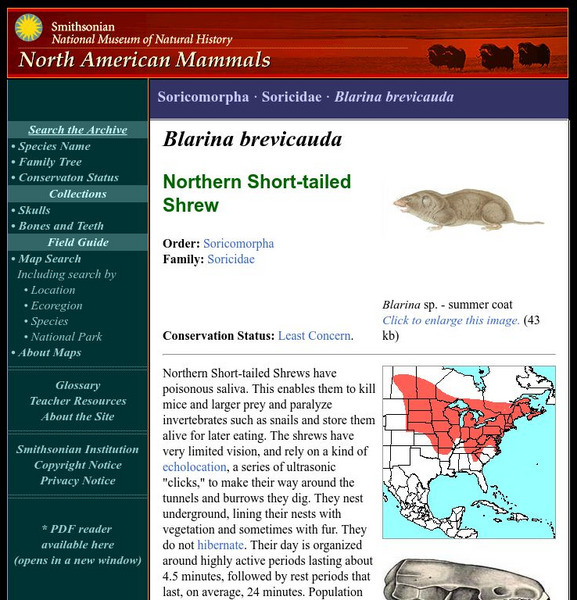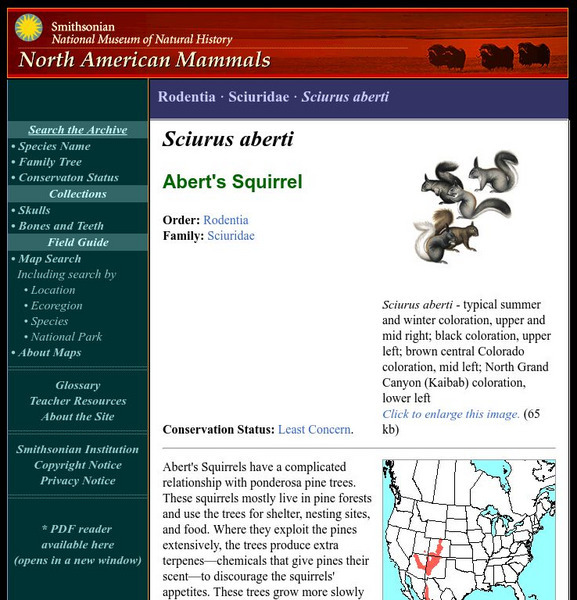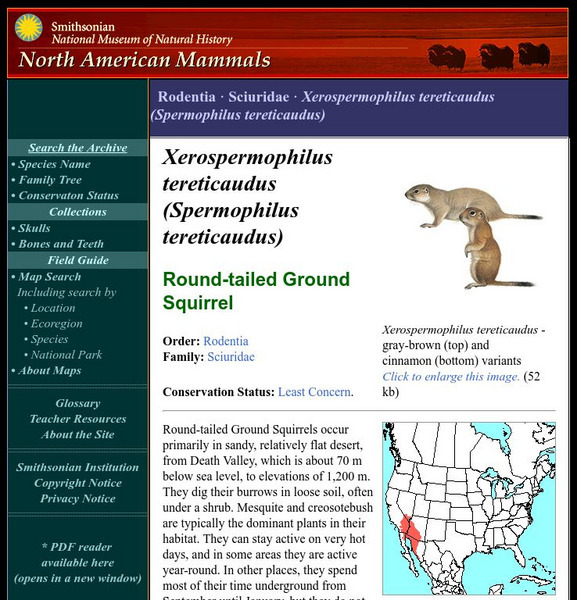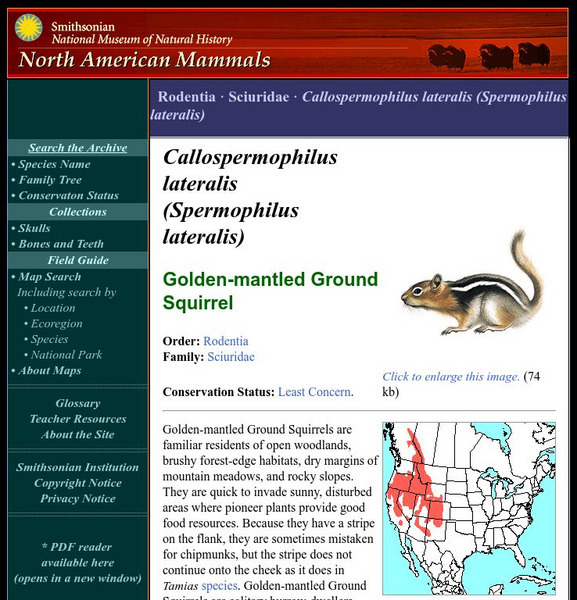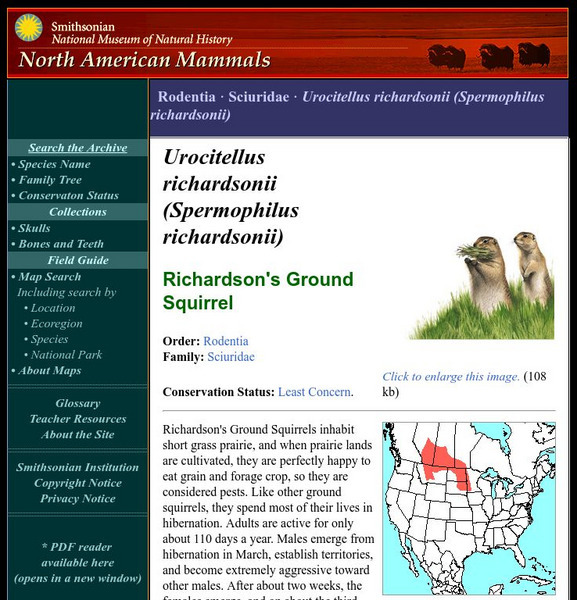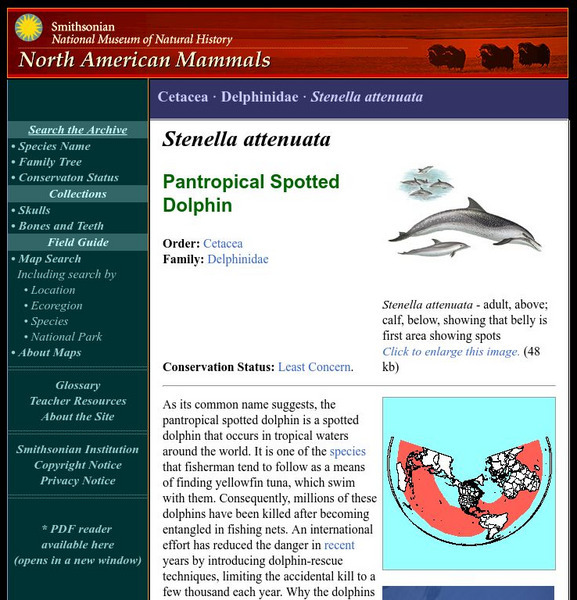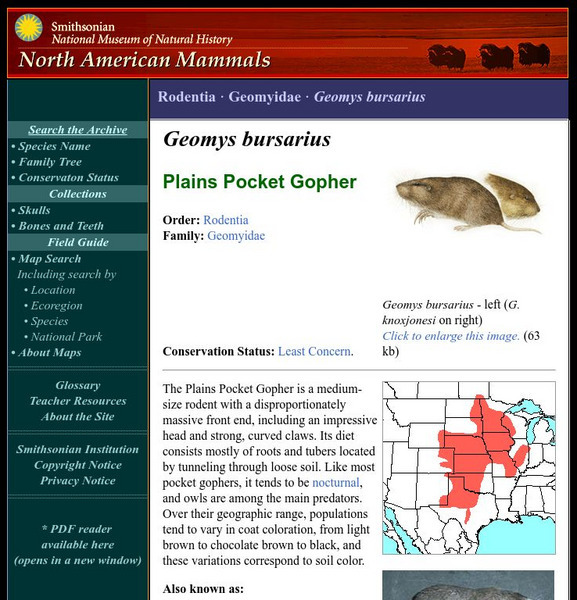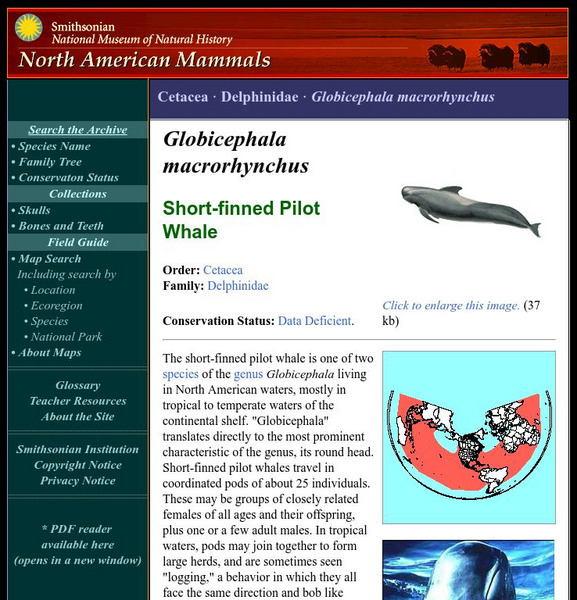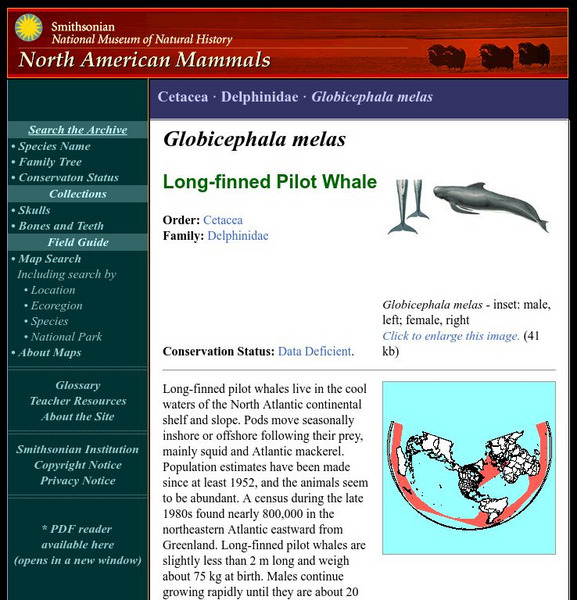Smithsonian Institution
National Museum of Natural History: American Mammals: Bearded Seal
Bearded seals have relatively small heads and prominent whiskers. Males and females are similar in size and appearance. Learn more about the Erignathus barbatus, more commonly known as a Bearded Seal, in this easy-to-read species...
Smithsonian Institution
National Museum of Natural History: American Mammals: Baird's Pocket Gopher
Baird's Pocket Gopher is also known as the Louisiana Pocket Gopher, though most of what is known about its ecology has come from studies of the species near College Station, Texas, and it occurs in Oklahoma and Arkansas as well as in...
Smithsonian Institution
National Museum of Natural History: American Mammals: Atlantic White Sided Dolphin
Like other species of the genus Lagenorhynchus, the Atlantic white-sided dolphin is a stocky animal with a short, thick snout. It is common in cold North Atlantic waters. Learn more about the Lagenorhynchus acutus, more commonly known as...
Smithsonian Institution
National Museum of Natural History: American Mammals: Pacific White Sided Dolphin
Before the United Nations established a moratorium on the use of high seas drift nets in 1993, Pacific white-sided dolphins were frequently caught in the nets of Japanese and Korean squid fisheries. Today the species is better protected,...
Smithsonian Institution
National Museum of Natural History: American Mammals: Alaskan Hare
Female Alaskan Hares nurse their young for an extended period, providing them with enough nutrition to grow extraordinarily quickly during the short Alaskan summer. There is an average of six furry little hares in a litter, and females...
Smithsonian Institution
National Museum of Natural History: American Mammals: Northern Right Whale Dolphin
With no dorsal fin, a slender body shape that tapers steadily toward the tail, and small flippers and flukes, the northern right whale dolphin appears to be built for speed. It has been clocked at 34 km per hour and can dive as deep as...
Smithsonian Institution
National Museum of Natural History: American Mammals: Alaska Marmot
The Alaska Marmot lives in the Brooks Range, in northern Alaska, squeezing between big, bulky rocks on slopes to dig its dens. Denning on rocky ledges or under boulders offers them some protection from grizzly bears, which would...
Smithsonian Institution
National Museum of Natural History: American Mammals: Ginkgo Toothed Beaked Whale
Almost nothing is known of the ginkgo-toothed beaked whale. Nothing about its behavior or feeding habits has been reported, and its geographical distribution is estimated from a very small sample. Learn more about the Mesoplodon...
Smithsonian Institution
National Museum of Natural History: American Mammals: Western Small Footed Myotis
The western small-footed myotis occurs in limited areas of southwestern Canada, throughout much of the western United States, and into Mexico. It is better adapted to moist areas than to dry ones. Learn more about the Myotis ciliolabrum,...
Smithsonian Institution
National Museum of Natural History: American Mammals: Northern Short Tailed Shrew
Northern Short-tailed Shrews have poisonous saliva. This enables them to kill mice and larger prey and paralyze invertebrates such as snails and store them alive for later eating. Learn more about the Blarina brevicauda, more commonly...
Smithsonian Institution
National Museum of Natural History: American Mammals: Southern Short Tailed Shrew
The Southern Short-tailed Shrew is a highly active, primarily nocturnal predator. It is most common in moist, well-drained hardwood forests or pine stands, especially where deep organic litter provides easy burrowing for shelter and...
Smithsonian Institution
National Museum of Natural History: American Mammals: Abert's Squirrel
Abert's Squirrels have a complicated relationship with ponderosa pine trees. These squirrels mostly live in pine forests and use the trees for shelter, nesting sites, and food. Learn more about the Sciurus aberti, more commonly known as...
Smithsonian Institution
National Museum of Natural History: American Mammals: Round Tailed Ground Squirrel
Round-tailed Ground Squirrels occur primarily in sandy, relatively flat desert, from Death Valley, which is about 70 m below sea level, to elevations of 1,200 m. They dig their burrows in loose soil, often under a shrub. Learn more about...
Smithsonian Institution
National Museum of Natural History: American Mammals: Golden Mantled Ground Squirrel
Restricted to the Cascade Mountains of Washington State and British Columbia, Cascade golden-mantled Ground Squirrels are so similar to golden-mantled Ground Squirrels that some scientists consider them the same species. However, their...
Smithsonian Institution
National Museum of Natural History: American Mammals: Golden Mantled Ground Squirrel
Golden-mantled Ground Squirrels are familiar residents of open woodlands, brushy forest-edge habitats, dry margins of mountain meadows, and rocky slopes. They are quick to invade sunny, disturbed areas where pioneer plants provide good...
Smithsonian Institution
National Museum of Natural History: American Mammals: Richardson's Ground Squirrel
Richardson's Ground Squirrels inhabit short grass prairie, and when prairie lands are cultivated, they are perfectly happy to eat grain and forage crop, so they are considered pests. Like other ground squirrels, they spend most of their...
Smithsonian Institution
National Museum of Natural History: American Mammals: Pantropical Spotted Dolphin
As its common name suggests, the pantropical spotted dolphin is a spotted dolphin that occurs in tropical waters around the world. It is one of the species that fisherman tend to follow as a means of finding yellowfin tuna, which swim...
Smithsonian Institution
National Museum of Natural History: American Mammals: Richardson's Collared Lemming
Richardson's Collared Lemmings are active 24 hours a day. They are found in tundra, and avoid marshy habitats and forested areas. Learn more about the Dicrostonyx richardsoni, more commonly known as a Richardson's Collared Lemming, in...
Smithsonian Institution
National Museum of Natural History: American Mammals: Agile Kangaroo Rat
Agile Kangaroo Rats are excellent swimmers. They can run on all four feet as well as hop on their large hind feet, and if they are fleeing a predator, can make sharp turns. Learn more about the Dipodomys agilis, more commonly known as an...
Smithsonian Institution
National Museum of Natural History: American Mammals: Chisel Toothed Kangaroo Rat
The Chisel-toothed Kangaroo Rat has chisel-shaped lower incisors, with which it strips the epidermis from the leaves of desert shadscale or saltbush, thereby reaching the palatable and water-rich interior of the leaf. This Kangaroo Rat...
Smithsonian Institution
National Museum of Natural History: American Mammals: White Footed Vole
White-footed Voles inhabit a relatively small area of the Pacific coast of North America, from Humboldt Bay, California, north to the Columbia River. They have small eyes, and their claws are suitable for burrowing, so they probably have...
Smithsonian Institution
National Museum of Natural History: American Mammals: Plains Pocket Gopher
The Plains Pocket Gopher is a medium-size rodent with a disproportionately massive front end, including an impressive head and strong, curved claws. Its diet consists mostly of roots and tubers located by tunneling through loose soil....
Smithsonian Institution
National Museum of Natural History: American Mammals: Short Finned Pilot Whale
The short-finned pilot whale is one of two species of the genus Globicephala living in North American waters, mostly in tropical to temperate waters of the continental shelf. "Globicephala" translates directly to the most prominent...
Smithsonian Institution
National Museum of Natural History: American Mammals: Long Finned Pilot Whale
Long-finned pilot whales live in the cool waters of the North Atlantic continental shelf and slope. Pods move seasonally inshore or offshore following their prey, mainly squid and Atlantic mackerel. Learn more about the Globicephala...









